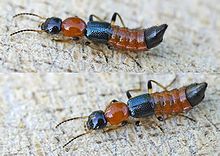Nairobi fly
| Nairobi fly | |
|---|---|

| |
| Scientific classification | |
| Kingdom: | |
| Phylum: | |
| Class: | |
| Order: | |
| Family: | |
| Genus: | |
| Species: | P. eximius
and P. sabaeus |
The name Nairobi fly or Kenya fly is applied to two species of beetle which live in East Africa, Paederus eximius and Paederus sabaeus.
The Nairobi fly is a common example of an insect that contains a corrosive substance known as pederin.[1] They are species of the rove beetle genus Paederus, and are black and red in colour, and about 6–10 mm long.[2] They live in rotting leaves where they lay their eggs.
The beetles neither sting nor bite, but their haemolymph contains pederin, a potent toxin that causes blistering and Paederus dermatitis. The toxin is released when the beetle is crushed against the skin, often at night, when sleepers inadvertently brush the insect from their faces. People are advised to gently brush or blow the insect off their skin to prevent irritation.[1]
Heavy rains, sometimes brought on by El Niño events, provide the conditions for the Nairobi fly to thrive. Outbreaks have occurred in 1998[1] and 2007.[3]
See also
References
- ^ a b c "'Nairobi fly' doesn't sting or bite, but it sure does hurt". CNN. January 26, 1998. Archived from the original on January 28, 2007.
- ^ Stefano Veraldi & Luciano Süss (1994). "Dermatitis caused by Paederus fuscipes Curt". International Journal of Dermatology. 33 (4): 277–278. doi:10.1111/j.1365-4362.1994.tb01045.x.
- ^ Arthur Okwemba (May 27, 2007). "Beware, the Nairobi fly is back in town". bushdrums.com.
